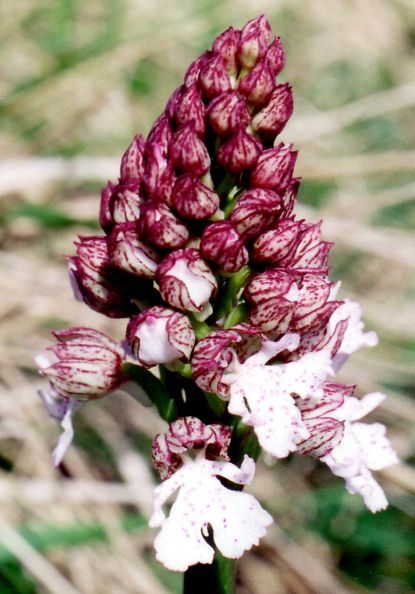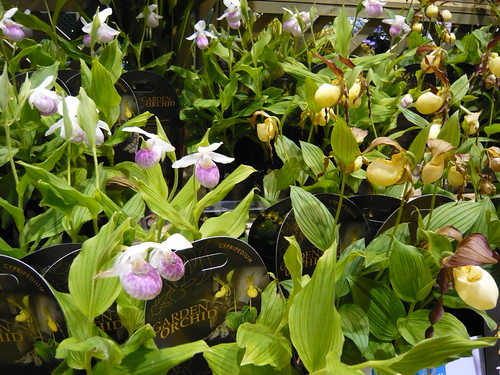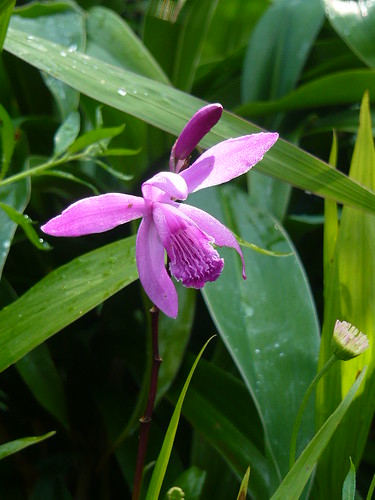Wild Orchids in Britain

There are a surprising number of Orchid species that grow wild in Britain. Because they are so special they should be left in the wild and only purchased from credible suppliers who cultivate their own stock.
The Lady Orchid Orchis purpurea grows up to 2’6″ and the purple speckled flowers on a robust spike make this one of the most popular Wild Orchids in Britain. It flowers in early May in scrub or woodland.
Helloborine Large White is found in Beech woods with chalky soil. It flowers 12-18 inches high in early June. The Narrow Leaved Helleborine is more wide spread especially in shady chalky areas. The Broad Leaved Helloborine grows up to 3 feet high and flowers red or pink in August. The Marsh Heleborine prefers to grow in alkaline marsh land but in the open it collonises some older sand dunes.
Early Purple Orchids Orchis elatior have spotted leaves and shaped roots that are symbolic of the name which means testicles. It is sometimes mistaken for the Green-Winged Orchid which grows out in the open and is pollinated by Bees.
Common Twaybaldes have a distinctive pair of heart shaped leaves. It is so slow growing it may take 12 years before it flowers. Lesser Twayblade has heart shaped leaves and grows in acid soil on moorlands and bogs, flowering in July
Heath Spotted Orchid Dactylorhyza maculata erectum has numerous whiteflowers with dashes of purple resembling spots. In the same family is the Common Spotted Orchid which occurs throughout Britain. Also called ‘Deadmans Fingers’ after the shape of the roots.
Bee Orchids Orphrys apifera has flowers with 3 pink sepals and a velvety brown lip that gives the plant its name. The flower spike can grow 18 inches tall and have 2-7 widely spaced flowers which are self pollinating.
Fragrant Orchid Gymnadenia conopsea stands out well in grassland but numbers vary widely from year to year. The flowers vary in colour and there is a white and a purple variety. The Marsh Fragrant Orchid has a dense flower spike with a carnation like scent.
Lesser Butterfly Orchid grows on both chalky and acid soils and is confused with the Greater Butterfly Orchid. Both have long nectar filled spurs and are pollinasted by moths at night.
Burnt Orchids are dwarf orchids with dark coloured flower buds. The plant is very slow to flower amongst short grasses.
Man Orchid Aceras anthropophorum have an unpleasant smell that attracts hoverflies and insects and each open flower looks like a little man. The flowers are green yellow and blend into the scenery at the bottom of chalky slopes.
Pyramidal Orchids tend to be bright pink flowering and grow on sandy dunes. They have a sweet smell and a cone like flowerhead as the lower blossom opens.
Frog Orchids do not look like their names sake with inconspicuous green flowers. The Fly Orchid however has brown flowers in a convincing resemblance to a fly.
Lizard Orchid has strange flowers with a long ‘lizard-tail shaped’Â lip on a tall spike in July. Monkey Orchids have a hood that forms the head and five lips that form the arms and tail. It is very rare in Britain but common in Europe.
Autumn Lady’s Tresses is one of the latest flowering Orchids that emits a pleasant scent to attract Bees. The small Musk Orchids are also found growing in short turf in the South of England.
Early Marsh Orchids grow in water meadows and have purple flower spikes. They are related to Northern Marsh Orchids and Dwarf Purple orchids and are difficult to tell apart.
Bog Orchids and Fen Orchids as the names suggest like wet places. They are both quite small but the bog orchid as the smallest at 1-4 inches.
Coral Root Orchids are confined to the North of England & Scotland amongst sand dunes or pine forests. The plants have no leaves and the only chlorophyll is in the flower stalk. Jersey Orchids are loose flowered damp meadow flowers from the far South.


